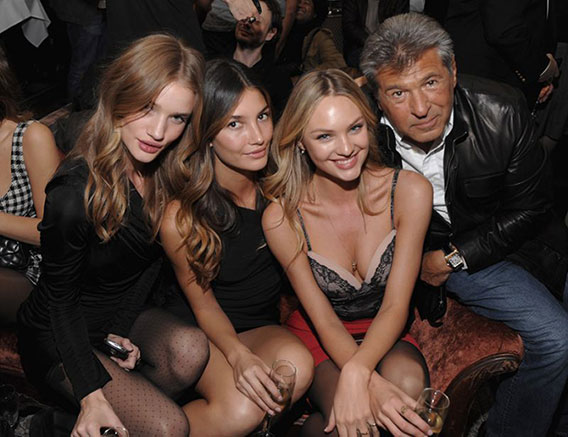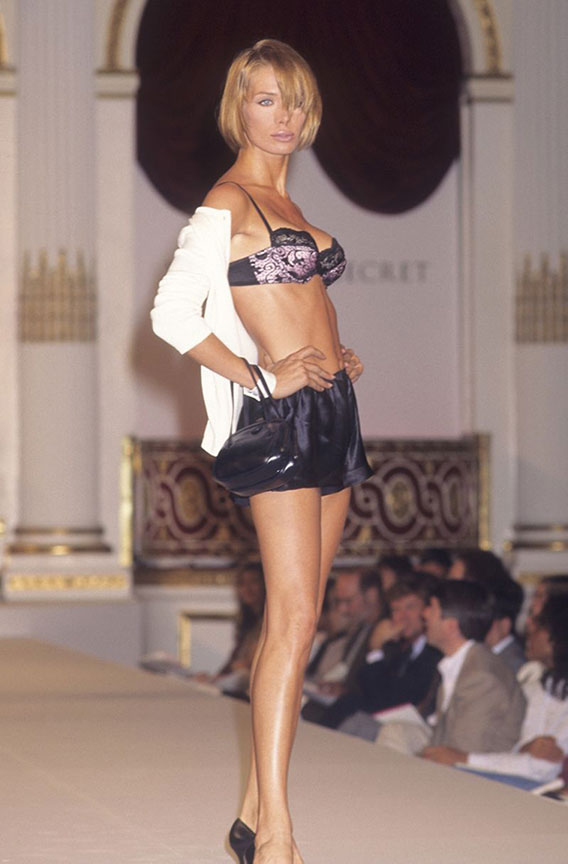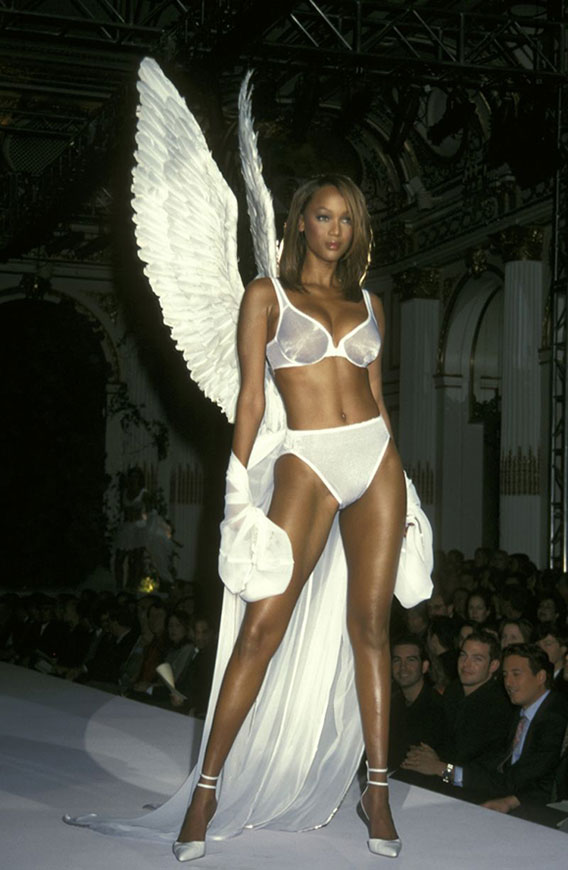Victoria’s Secret Created an Impossible Ideal of Sexy. Now It’s Struggling to Stay Relevant
 Here’s a very interesting article about Victoria’s Secret, it’s beginning and struggles. How should it evolve to continue the be successful in today’s world?
Here’s a very interesting article about Victoria’s Secret, it’s beginning and struggles. How should it evolve to continue the be successful in today’s world?
I’m sure all you fans and business-minded photographers may have an opinion. Let’s get the conversation started! (This article appeared in Time.com)
Picture a young Candice Bergen look-alike–gorgeous and sophisticated–lounging in a dim, velvety boudoir. She lives in London, where she runs her own design studio. She’s in her 30s and globetrots. She has the accent of her English father, and her life is informed by the lavish trips she took as a child with her French mother to Paris, Milan and New York City.
This is Victoria, the imaginary creator of Victoria’s Secret. At least as corporate employees have been told over the years to envision her: a worldly woman who loves lingerie and is passionate about helping women feel sexy. Customers may not know her backstory, but they should be drawn to her glamour as they walk through the stores. She’s the reason for that sultry British accent in the brand’s commercials.
As unattainable as that life seems, the company’s public ideal may be even more out of reach. Victoria has for decades been embodied by the Angels, an elite group of contracted supermodels who have helped define the American ideal of sexiness. Their come-hither glances and sculpted bodies–which hardly vary in size and shape–have successfully seduced millions of women into turning to Victoria’s Secret by default when they need a new bra. Those anointed–a group that includes Heidi Klum, Tyra Banks and Gisele Bündchen–are among the most famous models and women in the world, recognizable to many by their first names alone.
For a long time, playing on these two fantasies–being as alluring as the brand’s Angels and living a life of European luxury–resulted in fabulous success. Victoria’s Secret counts 1,170 stores in the U.S. and Canada with an additional 460 in more than 70 countries around the world. It’s the only retailer with its own fashion show on network television. During the height of its popularity, in the fiscal year that ended in January 2016, Victoria’s Secret recorded more than $7.7 billion in sales, accounting for more than half of all revenue at its parent company L Brands, which also owns Bath & Body Works, among other brands. Just a few weeks earlier, L Brands’ stock reached its all-time high of more than $100 a share.
 Chief marketing officer Razek poses with models Rosie Huntington-Whiteley, Lily Aldridge and Candice Swanepoel in 2009
Chief marketing officer Razek poses with models Rosie Huntington-Whiteley, Lily Aldridge and Candice Swanepoel in 2009
Since then, however, Victoria’s Secret has struggled. Sales have fallen. L Brands’ stock has plunged below $40. On Nov. 19, the company announced it was cutting its annual dividend in half. And CEO Jan Singer recently stepped down after only two years on the job.
Perhaps the most important factor in this decline is the reality that the company’s one-note definition of sexy is no longer shared by many American women. Of course, plenty are still interested in push-up bras and would love to have the abs of an Angel, and L Brands is hardly the only brick-and-mortar retailer to face headwinds in the era of online shopping. But as brands like Aerie, ThirdLove and Rihanna’s Savage X Fenty move into the market, capitalizing on the sex appeal of all body types, Victoria’s Secret finds itself an odd fit for lingerie’s new feminist era.
In an Instagram post in October, the model Robyn Lawley called for a boycott of the brand’s fashion show until Victoria’s Secret “commits to representing ALL women on stage.” Meanwhile, Rihanna has drawn an explicit contrast between their brand and hers: “I’m not built like Victoria’s Secret girl,” she told Vogue in a profile touting the launch of Savage X Fenty.
Roxanne Meyer, retail analyst at MKM Partners, calls L Brands founder and CEO Les Wexner a “visionary” but questions if he’s setting up his company for future success. “Everything I’ve read that Les has said–and I’m assuming he’s stuck by this–is he stands by his brand and what’s sexy and that’s what his customer wants,” she said. “I do wonder, Do they see the potential for Victoria’s Secret to evolve at all away from just pure sexy?”
Wexner, 81, has remained at the helm for decades, and L Brands’ chief marketing officer, Ed Razek, 70, continues to be the key figure shaping the brand’s image, even after recent comments brought a cascade of negative attention to the company. The backlash was swift in November after Razek, asked by Vogue about casting transgender models in the fashion show, said, “Shouldn’t you have transsexuals in the show? No. No, I don’t think we should. Well, why not? Because the show is a fantasy.” Razek also said the brand had “looked at putting a plus-size model in the show” but always decided against it. (Razek later apologized for the comments and said the brand is open to casting transgender models.)
So when ABC airs this year’s Victoria’s Secret Fashion Show on Dec. 2, the event will likely look pretty much as it always has–like the unchanging Victoria. But while what you see on TV may reflect the vision of the men in charge, it’s not necessarily one shared across the company. Former employees say that some internally have questioned the brand’s devotion to Razek’s view of “sexy” for years, even before profits started slipping.
“Their whole mentality of this girl seems a little bit outdated,” said one former employee who worked on the brand’s catalog in the early 2010s and who, like others interviewed for this story, requested anonymity for fear of career repercussions, “especially in today’s climate where women have so much more of a voice and we don’t want to be seen as sex symbols.”
In 1977, a businessman named Roy Raymond opened the first Victoria’s Secret store after feeling awkward buying lingerie for his wife in a department store. A handful of stores later, in 1982, Wexner bought Victoria’s Secret for L Brands (known then as The Limited Inc.) for $1 million. Lee Peterson, executive vice president at retail consultancy WD Partners, remembers visiting one of the first Victoria’s Secret stores in San Francisco just after the purchase.
“You went inside and it was like a boudoir … velvety and lush velvet curtains and all this–and I remember walking out of there like, What the hell is he thinking?” Peterson said.
At the time, there were few options for sexy, affordable lingerie. Frederick’s of Hollywood had been around for decades but was seen by many consumers as too racy. Peterson, who ended up working for L Brands from 1980 to 1991 and considers Wexner a mentor, quickly understood the brand’s potential as they started opening more stores. “They were on fire right from the get-go,” he said. By 1986, just four years after it was acquired, Victoria’s Secret had 100 stores doing $100 million in sales.
The modern Victoria’s Secret was born when Razek joined the company in the mid-1980s. “He’s low-filter, funny as hell, swears a lot,” Peterson said. Razek decided the brand needed to own “sexy” and carefully controlled his vision.
In the late ’90s he contracted Russell James, a fashion photographer who continues to shoot for the company. “I’ve worked with many brands over the years,” James said. “Ed is probably the most hands-on.” Razek personally calls photographers before they get to set, attends every major bra-launch shoot and often makes changes on the spot once he gets there. He is known to observe even small photo shoots to offer his opinion on the model. James, who still sometimes sends Razek test shots of new models for consideration, credits him with “an uncanny ability” to spot talent.
 Angelika Kallio in the 1995 debut show
Angelika Kallio in the 1995 debut show
Razek still personally approves the casting of each Angel and is said to be extremely protective of these women, according to former employees. “I loved him,” Bündchen said in a recent interview. Razek gave her a life-altering contract with Victoria’s Secret in 1999, which provided 80% of her income by the time she left eight years later, and she remains in touch with him. Reporting backstage before one show years ago, I noticed Miranda Kerr, then an Angel, rising from her makeup chair to embrace Razek as soon as he entered the room.
When Ivan Bart, president of IMG Models and IMG Fashion Properties, first started sending models to be cast for the fashion show, even the idea of modeling lingerie on a runway was unusual. That’s all changed. “I would say every model that comes to see us right now,” he said, “the goal is to be on the Victoria’s Secret runway.” Added Maja Chiesi, an IMG senior vice president and one of the world’s top modeling agents: “I don’t think there’s any other exposure on a runway that would probably ever compete with Victoria’s Secret because you’re on TV.”
In 1999, Razek decided to use the still embryonic technology of video streaming to put the fashion show online. It was the Internet-breaking moment of its era. Some 1.5 million visitors attempted to tune in, but many had trouble as the huge audience overwhelmed the servers. In 2001, the show aired on ABC and Heidi Klum walked the runway as the show’s star, her bosom barely contained by a multimillion-dollar diamond-encrusted “fantasy bra” that has become a staple of each show. Some 12.4 million viewers watched. By last year, with live TV viewing battered by streaming and Victoria’s Secret’s sales down, fewer than 5 million people watched.
“Top 12 marketing rules” is a list compiled by Razek that is well known in the Victoria’s Secret marketing department. Razek has updated the copy over time, but the rules have remained mostly the same. In a recent version shared with TIME by a former employee, No. 11 reads: “Fall on your face, not on your ass.”
“There’s always a reason not to do something,” it continues. “Not to change the sign pack, not to move to next, not to flip to the new photography … Marketing doesn’t work that way. It’s always about next, new, fresh … Always move forward, always be aggressive, always get to next. Your world will never be perfect. That’s not a reason not to make it better now.”
But former employees say there has never been much desire for change–perhaps because the formula seemed to work so well for so long. Under Sharen Jester Turney, who was CEO of Victoria’s Secret from 2006 to 2016 after six years of overseeing direct sales, employees began pitching ways to evolve the Angels’ image. Ideas included interviews with the models about their lives or shooting them without makeup. Some employees who were there at the time say Razek, who as chief marketing officer controlled the brand’s visual direction, wasn’t interested. “I remember him saying something like, ‘No one cares about their voice, no one cares about the story, just keep it simple and sexy,’” one former employee who worked in the art department told TIME. A former employee who worked on copy agreed: “If you had a modern idea, you’d PowerPoint it, pitch it for a month. Then they’d say, ‘We love this but we’re going to do what we did last year.’” Turney declined to comment.
The look of the Angels remained so consistent that even models with short hair were considered a departure. “When Karlie Kloss cut her hair, it was a big [moment]. Like, Oh my God,” said a former senior-level employee. And different body types were not embraced by upper management, according to this employee. “They’ve never felt a large body is sexy.”
 Tyra Banks dons angel wings in 1998
Tyra Banks dons angel wings in 1998
During one meeting, according to the former art-department employee, Razek compared the models to “thoroughbreds” and said he follows them closely on Instagram to make sure that they’re not being pushed too far by their agents because, like racehorses, you can’t overwork them or they would get exhausted and not perform at their best. Victoria’s Secret did not make Razek available for comment.
Then, in 2016, with the Victoria’s Secret brand still raking in sales, came three big changes. First, Turney left abruptly in February of that year, citing a desire to focus on her family, and Wexner, the L Brands chairman and CEO, also took on the job of CEO of Victoria’s Secret before appointing Jan Singer, formerly of Spanx, that June. (Singer did not return email requests for comment.) Second, Wexner decided to kill the iconic but costly Victoria’s Secret catalog and restructure the company, laying off 200 people. And third, a month after the layoffs, Wexner cut the brand’s swimwear, alienating some shoppers who were drawn into the stores for bathing suits and would pick up other products along the way. “We were making a lot of headway under Sharen,” the former senior-level employee told me, “but I feel like it reverted back to where it was with the girls in the long hair.”
Despite the public criticism and recent financial losses, L Brands remains a behemoth, accounting for 62.8% of total lingerie-industry revenue from U.S. brick-and-mortar sales, according to market-research firm IBISWorld. Aerie, for all of its buzz, accounts for just 3.5%, according to the IBIS World estimates.
“They’ll survive,” said NPD retail analyst Marshal Cohen. While analysts criticized Victoria’s Secret for missing the trend of unpadded bralettes, Jennifer Zuccarini, the founder of upscale lingerie line Fleur du Mal who worked in design at Victoria’s Secret from 2008 to 2012, said she always put bralettes in the collection but they didn’t sell. “They’ve trained their consumer to want a certain look,” she said. “A more extreme underwire padded sort of thing.” This gave Aerie an in, but Cohen said he doubts it will hurt Victoria’s Secret in the long run. “Do I think we’ll be talking in the near future about how they’ve done well on the rebound side?” he said. “I think give it some time and we will.” Just this month, the brand announced on an earnings call that it will bring back swimwear in 2019.
What’s more, the company is doing a lot of things right. People who have worked at Victoria’s Secret cite generous salaries, a high proportion of women in leadership positions, and a talented workforce as perks. But to get all that, the former art-department employee said, you have to “swallow this really big pill”: the brand’s unapologetic objectification of women.
Some change seems inevitable, if only due to Razek’s and Wexner’s advancing ages. “Les can’t be like 90 years old and pushing Victoria’s Secret’s bralette business,” Peterson said. Next year, there will be a new Victoria’s Secret CEO to replace Singer: Tory Burch president John Mehas. Which means the future of “sexy” is, once again, in the hands of a man.
[time]
© 2010-2018 Copyright ShootTheCenterfold.com. All rights reserved.






















hello group and STC INC. I just read this article, and it makes me very interesting, I personally have a vision and I confirm it when women see my photos of boudoir, the first thing they tell me, that nice, very elegant, and sensual photos, here I pick up those words and I apply them here, why change a thing that gives positive results, I am aware that the world advances, but not everything is good today, I applaud that behind Victoria’s secret is a man, and not because of machismo, but because who better than a man to know what a woman looks like and what we like to see men